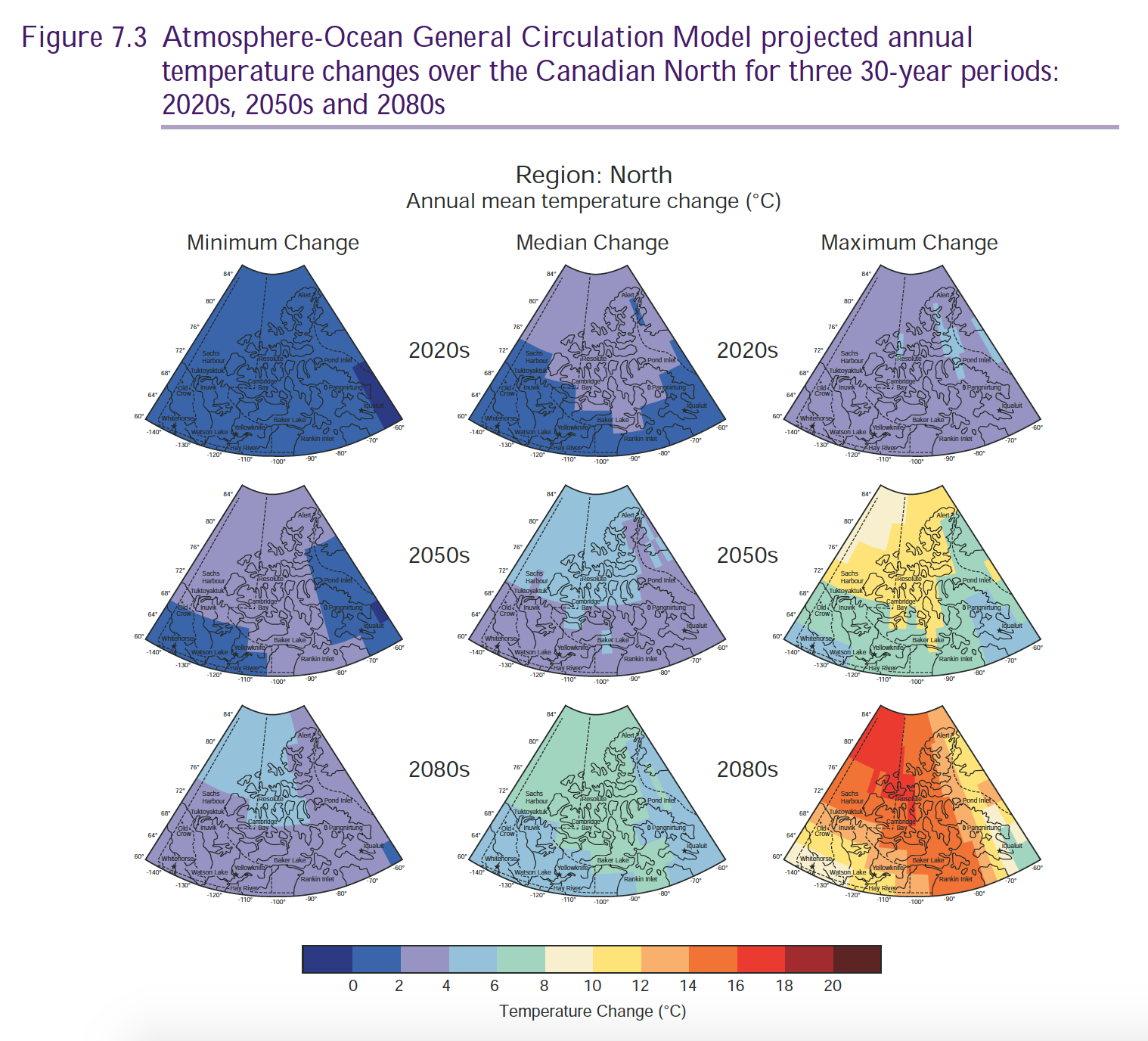Temperature-related Injuries
The greatest warming in the Canadian North is expected during the winter months, and more dramatic warming (above current regional norms) in the future is projected for the extreme northwest (Old Crow, Yukon). Therefore, with decreases in mean winter cold temperatures, one might expect a reduction in cold-related injuries, such as frostbite and hypothermia, among all northern residents, particularly among those who are the most exposed (i.e. Aboriginal residents and others spending extended periods of time outdoors). In the Yukon First Nations Regional Health Survey, residents reported that 2%, 7% and 1% of injuries among adults, youth and children, respectively, were cold-related (hypothermia, frostbite or other). However, the relationship between exposure to cold and individual behaviours is more complex.
For example, winter warming may be associated with increased weather instability; consequently, individuals may experience increased exposure to cold associated with storms and other hazardous conditions while out on the land. Therefore, a linear reduction in cold-related injuries because of warmer temperatures, cannot be assumed.
Some reports of respiratory distress on very hot days in the summer have been reported among Elders in Nunatsiavut and Nunavik in recent years. Although current modelling of temperature extremes does not allow for a precise projection of the maximum temperatures to be expected, in northern Sweden, scientists have argued that a temperature rise of only 1°C can be associated with an increase in non-fatal acute myocardial infarctions (heart attack) by 1.5%. He proposed that this increase could be explained by a disruption in adaptation and a resulting increase in susceptibility to atherosclerosis diseases where the arteries of the heart become narrowed and hardened due to a buildup of plaque around the artery wall. The current rates of heart attacks and cardiovascular-related deaths among all Northern residents are comparatively lower than the national average in Canada. However, cardiovascular and respiratory diseases like asthma, chronic bronchitis, emphysema and pneumonia are significant causes of mortality and hospitalization in many Northern regions.
As the climate changes, ongoing fluctuations in the climate system are likely to result in new temperatures and extremes of heat; these will add to health-related stresses, and are likely to increase in frequency, particularly in summer daily temperatures greater than 30°C.

Ultraviolet Rays (UV)
With increasing concentrations of atmospheric GHGs and the consequent trapping of more heat below the stratosphere, stratospheric cooling will occur. This is likely to increase the frequency and severity of episodes of stratospheric ozone depletion. Ozone concentrations in the stratosphere influence the amount of UVB radiation reaching the Earth’s surface. Therefore, there is a relationship between GHG emissions, climate change and UV radiation.
Despite international action to reduce and eliminate the use of ozone-harming chemicals, like aerosol hairspray, through the Montreal Protocol, these substances remain in the atmosphere for long periods of time. Ozone repair is expected to take at least until 2050. Ozone depletion at polar latitudes peaks during late winter and early spring, when significant outdoor activity occurs in our communities such as Toonyk Tyme, snowmobile races, ice fishing and dog sledding. The potential human health effects of enhanced UV exposure are therefore important to consider in the context of projected climate change.
Although current rates of skin cancers are low in the North, community residents have reported increased incidence of sun rashes, burns and snow blindness in recent decades and in regions where these ailments were not previously observed. In humans, UV exposure has been linked to conditions such as melanoma, cataracts, immunosuppression and non-Hodgkin’s lymphoma, among others. Data on the incidence and distribution of such conditions and their relationship to current levels of UV exposure among Arctic populations are lacking. However, they warrant attention considering the projections of low ozone and elevated UV reaching the Earth’s surface for several decades into the future. This is especially important for those northern residents frequently exposed to the sun for long durations, such as Inuit hunters who spending significant periods of time on the land hunting and travelling during the late winter and early spring.

Copyright © All Rights Reserved

